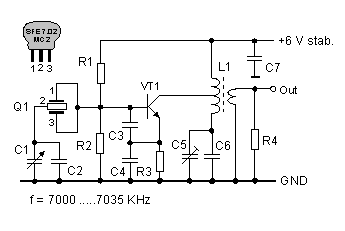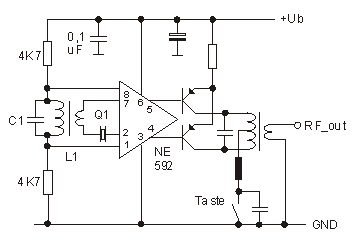
Many thanks to Ruel N1GG for the excellent revision of the following text
VFO with Ceramic Resonator
A 7 MHz oscillator with a variable crystal oscillator (VXO) operates very stably, but it allows only a small frequency variation (approx. 5 kHz). In contrast, a VFO with an LC resonant circuit can be tuned over a range of several hundred kHz, but its frequency stability will depend upon its construction. The use of a ceramic resonator as frequency-determining component fulfills both requirements. The following oscillator circuit, which uses a ceramic resonator, offers a tuning range of 35 kHz with good frequency stability. The somewhat unusual resonant LC circuit at the collector of VT1 has two functions. It improves the shape of the output signal and at the same time compensates the amplitude drop starting at approximately 7020 kHz. The transfer characteristic of the ceramic resonator gives this effect. The resonant LC circuit must be adjusted for maximum output amplitude (2Vss) at 7035 kHz. The oscillator needs a regulated voltage of +6 V for proper operation.
The resonant LC circuit can also be tuned to the second, third or forth harmonic. For an improved signal shape however, an extra tuned amplifier stage is necessary. With this adjustment the oscillator is capable for use on 20 meters (14000-14070 KHz), 15 meters (21000-21105 KHz) or 10 meters (28000-28140 KHz).
Fig. 1: Oscillator with a ceramic resonator

Unfortunately, I have had problems with finding this particular ceramic resonator. The Murata resonator with this frequency value hasn't been listed lately (since the beginning of 2001) in my preferred component supplier's catalogue (Reichelt company). If someone knows of another source, please E-Mail me. Note that the ceramic resonator is also suitable as an input filter on the 40 meter band. As everyone knows, this band contains many adjacent strong signals that need to be suppressed for good reception of weaker signals.
| Parts No. | Value |
|---|---|
| R1 | 27 kOhm |
| R2 | 22 kOhm |
| R3 | 220 Ohm |
| R4 | 47 Ohm |
| C1 | 20 ... 325 pF, variable capacitor |
| C2 | 100 pF |
| C3 | 680 pF |
| C4 | 330 pF |
| C5 | 5 ... 90 pF trim capacitor |
| C6 | 220 pF |
| C7 | 0,1 uF |
| L1 | T50-2, red 2 x 8 turns, prim. bifilar 2 turns sec. |
| VT1 | 2N3904 |
| Q1 | SFE 7.02 M2C, Murata |
Power Oscillator
You can build a power oscillator with an NE592 and some additional parts.
Depending on the crystal frequency, RF power generation in the range of 1 to 30
MHz is possible. The parallel resonant circuit C1/L1 must be tuned exactly to
the crystal frequency. For final transistors one can use two 2N3906 or BS250
(see QRP push-pull amplifier). RF power output can be adjusted from 20 mW to
1.5 W by varying a common emitter resistor in the push-pull stage.
Do not use this circuit as a transmitter. When keying the NE592 power
supply (pin 3) frequency variation (chirp) occurs. If you insist on
transmitting with this circuit, then switch the final transistors directly. To
do this put a 10 uH choke in series with the key and a 0.1 uF capacitor in
parallel. Disadvantages of this circuit are the NE 592 quiescent current (18
mA), the continuously working oscillator and the hard keying.
Fig. 1: Power oscillator
 </
</